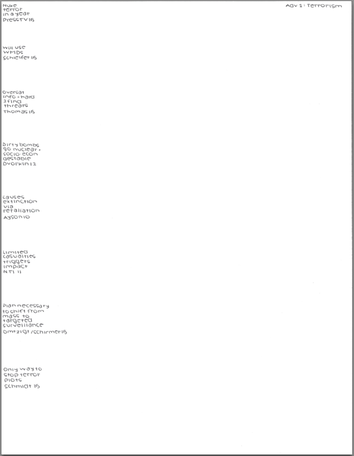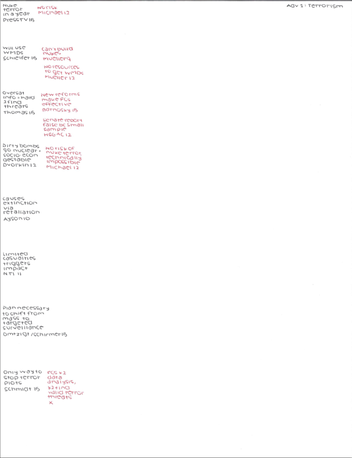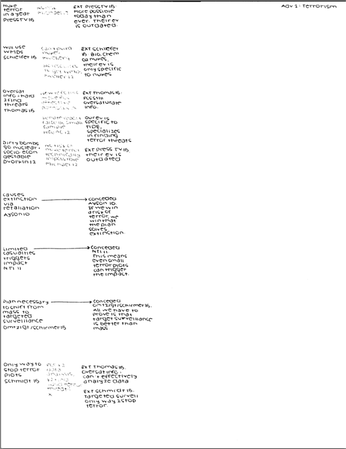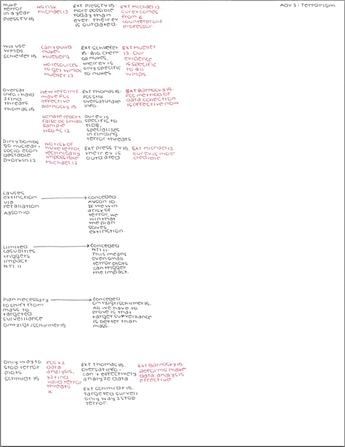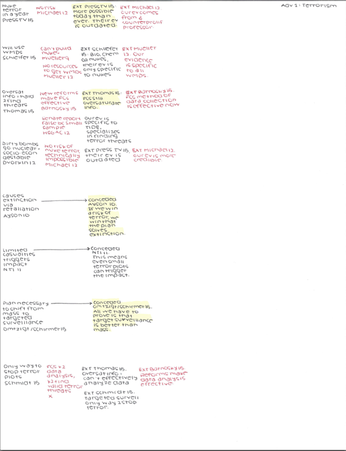Flowing
What is flowing?
|
When I say the word flow, what came to mind? When I first heard of flowing, I thought of some dreamy island with gentle waves and maybe a hula girl or a cartoon sea creature singing with a ukulele.
But whatever romantic vision you had, snap out of it. Flowing is simply just a way to take notes and keep track of the debate. And it's not "peaceful island dream" kind of note-taking. It can actually be pretty stressful when your opponents speak at 1000 miles per hour. Flowing is an important way to keep track of what's going on in the debate. This is absolutely crucial to make sure that you answer the arguments that need to be answered and keep up with what your opponents dropped. |
How do I flow?
You're going to need:
- 2 pens of different colors
- a stack of legal sized paper
- highlighters (this is optional)
- 2 pens of different colors
- a stack of legal sized paper
- highlighters (this is optional)
First, make sure you have a lot of paper. Each advantage/contention that the affirmative team has as well as every off-case argument that the negative team has requires its own sheet of paper.
Second, set up your papers correctly.
Second, set up your papers correctly.
|
You want your papers to be vertical:
|
This is incorrect:
|
|
It's important to flow vertically, because you will be flowing downwards. This ensures that you have enough space to flow every card with space in between.
In each upper right hand corner, you should label what argument is on the flow. For example, if the affirmative team's first advantage is cloud computing, I'll write down "cloud" in the upper right hand corner. For negative off-case arguments, you can label topicality as T, disadvantages as DA, and counterplans as CP. If there's more than one of one type of argument, use a word or two to tell them apart. (If the negative team runs 2 T arguments, put "T: <insert word here>" in the corner to differentiate them.) |

Third, you want to make sure you write down every tag, author and date. Don't worry if you can't get it all the first time around, just keep practicing. The tag is the most important thing, because it allows you to identify what the argument is saying. Authors and dates are important, because as you get more advanced, you will refer to evidence by the card's author and date. (Ex. "Our Allison 97 evidence indicates...")
✪ Tip: Always have one person on your team flow exactly what the opponent is saying and follow along with the speech doc. When you are too dependent on the speech doc, you might accidentally flow something that they didn't say or you miss something they said that wasn't in the file they sent you (such as analytics).
Fourth, make sure that you have space between each argument of the first speech. Around three fingers worth of space between each argument in the 1AC and 1NC is sufficient. This is because you're going to have to write down answers to each argument, and you want to make sure you have enough space to make your flow look organized so you'll be able to comprehend it and reference it for later speeches.
Fifth, write down answers to arguments right next to the argument that is being answered. This might sound self-explanatory, but when I was a novice, I would flow the answers the 1NC had to my case in the order of the 1NC, which wasn't always the order I made the arguments in. This meant I would have to draw a lot of arrows, and it would end up really messy.
Sixth, before each rebuttal, circle or highlight the arguments that you absolutely HAVE to go through. Your flow is important the entire debate, but it's especially crucial during the rebuttals. This will help you pick and choose arguments you absolutely have to answer and extend and allow you flexibility to group certain arguments together to save time. This is where it's
important to have a clean flow, so then you can actually read it.
✪ Tip: Develop a shorthand and abbreviate as much as possible. This will allow you to write things down quicker and not waste time getting every single word down. This is especially important when writing tag lines. Just make sure that both you and your partner can understand it, or else it's really tricky to use each other's flows for rebuttals.
✪ Tip: Always have one person on your team flow exactly what the opponent is saying and follow along with the speech doc. When you are too dependent on the speech doc, you might accidentally flow something that they didn't say or you miss something they said that wasn't in the file they sent you (such as analytics).
Fourth, make sure that you have space between each argument of the first speech. Around three fingers worth of space between each argument in the 1AC and 1NC is sufficient. This is because you're going to have to write down answers to each argument, and you want to make sure you have enough space to make your flow look organized so you'll be able to comprehend it and reference it for later speeches.
Fifth, write down answers to arguments right next to the argument that is being answered. This might sound self-explanatory, but when I was a novice, I would flow the answers the 1NC had to my case in the order of the 1NC, which wasn't always the order I made the arguments in. This meant I would have to draw a lot of arrows, and it would end up really messy.
Sixth, before each rebuttal, circle or highlight the arguments that you absolutely HAVE to go through. Your flow is important the entire debate, but it's especially crucial during the rebuttals. This will help you pick and choose arguments you absolutely have to answer and extend and allow you flexibility to group certain arguments together to save time. This is where it's
important to have a clean flow, so then you can actually read it.
✪ Tip: Develop a shorthand and abbreviate as much as possible. This will allow you to write things down quicker and not waste time getting every single word down. This is especially important when writing tag lines. Just make sure that both you and your partner can understand it, or else it's really tricky to use each other's flows for rebuttals.
Example of a Flow
Click on the flow in order to make it bigger.
Below is an example of the flow of one of the 1AC's advantages. Notice how the number and name of the advantage are clearly written in the right-hand corner. The gist of each card is written with space between each argument to accommodate answers.
Below is an example of the flow of one of the 1AC's advantages. Notice how the number and name of the advantage are clearly written in the right-hand corner. The gist of each card is written with space between each argument to accommodate answers.
Below is an example of the 1NC's responses to this part of the case.
- Notice that the negative's arguments are written in a different color than the affirmative's.
- Notice why it's important to leave space between affirmative arguments. Answers to arguments are often times longer than the argument itself.
- Notice that the answers to the arguments are right next to the arguments they are answering. This may mean jumping around your flow to write things down while the 1NC is talking.
- Notice that the negative didn't get the author of the last card. That is okay. Just put an X, or an indicator of your choice, so you can remember to ask during cross-ex if your opponents are paper debating, or look it up the speech doc during cross-ex or prep and fill it in.
(Apologies for the weird color change. I think I accidentally set it to grayscale when I scanned it. Oops!)
- Notice how the word "extend" is abbreviated with "EXT."
- Notice how analytics were also flowed, such as the conceded evidence.
- This is more relevant to argumentation rather than flowing: Notice how the affirmative uses the evidence already said in the 1AC to answer their opponents. This saves a lot of time instead of reading new cards that say the same thing.
Here is the block. Again, notice how argument answers are right next to the arguments they are answering. Notice abbreviations such as "EXT" for extend and "FCs" for "fusion centers."
Notice how certain arguments are highlighted. This is an example of what a flow should look like before each rebuttal. This shows which arguments are the most important and therefore are the ones that should be presented first and have the most time spent on them.
Extras
Callie Chappell, a college debater at University of Michigan, has a great video on flowing. You can click here to watch it.



